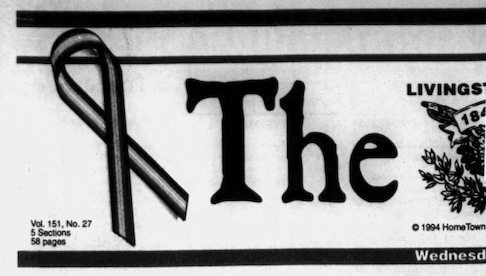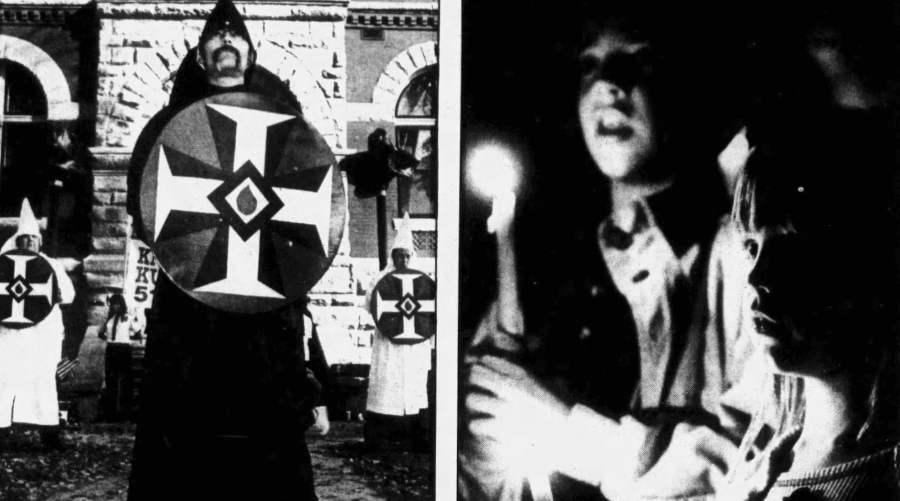 Twenty-five years ago, less than a dozen Klansmen from outside the community came to Howell for a rally on the steps of our beloved, historic Livingston County Courthouse.
Twenty-five years ago, less than a dozen Klansmen from outside the community came to Howell for a rally on the steps of our beloved, historic Livingston County Courthouse.

It’s the event that some say took place here because, well, it is Howell, after all, and you know about Howell’s reputation as a hot-bed of intolerance. But what those people don’t understand is that on this day, 25 years ago, leaders in Howell and Livingston County stood united and strong and told the Klan to go to hell.
One of those leaders was The Rev. Ben Bohnsack, who was at the time the pastor of the First United Methodist Church in Brighton. Bohnsack described the impending rally as an “assault on the values” of the community.
“We resent being portrayed in that image of racist Klan hatred,” Bohnsack said. “This is a time for our community to hold steady.”
And hold steady the community did.
The Howell rally was the first of two the Klan held that day; the second took place in Lansing. In both, less than a dozen robed Klansmen showed up to play loud music from a boombox, wave Confederate flags, and yell loudly.
The difference between the two rallies was that Livingston County residents — after a grassroots “Just Stay Away” campaign that operated on the premise of starving the Klan of the attention on which it fed — did, indeed, stay away. In Lansing, however, the result was different, with several canisters of tear gas deployed to control anti-Klan protestors, and some reports of minor property damage.
 Livingston County decided that if the Klan was coming to town, it — not the Klan — would control the situation. And so it was that starting at 5 a.m. Saturday, Oct. 22, 1994 — the day of the rally — the historic Livingston County Courthouse was put under the protection of 174 police officers representing every law enforcement agency in the county, in addition to some from Washtenaw and Oakland.
Livingston County decided that if the Klan was coming to town, it — not the Klan — would control the situation. And so it was that starting at 5 a.m. Saturday, Oct. 22, 1994 — the day of the rally — the historic Livingston County Courthouse was put under the protection of 174 police officers representing every law enforcement agency in the county, in addition to some from Washtenaw and Oakland.

Also protecting the historic courthouse was a hastily erected, 8-foot-tall, chain-link fence, which ringed the courthouse and included two additional sections on Grand River Avenue to contain protesters and observers. Construction of the fence began on Friday, Oct. 21, 1994, moments after a federal court judge ruled the Klan could hold its rally on the courthouse grounds the next morning.
Twenty-five years later, while that fence looms large in my recollection of the rally, (the column I wrote about it back then is reprinted at the end of this piece), what I remember most (and am most thankful for) is the message county officials and community leaders shouted out loud and clear — that hate has no home here.
The hate-based reputation was one carefully curated over the years by Robert Miles, the publicity-loving grand wizard of the KKK who lived on a farm in Cohoctah Township, north of Howell. It was on his farm that he hosted cross burnings and hate rallies.
Though Miles died in 1992, two years before the Klan rally, his legacy was a huge stain on the community’s reputation; Livingston County in general and Howell in particular have always had to push back against it. (You can read Buddy Moorehouse’s wonderful piece on Miles by clicking here.) When two teenagers burned a cross on the lawn of a Genoa Township couple in 1988, the community formed Livingston 2001 — now known as the Livingston Diversity Council. And in preparation for the 1994 Klan rally, the Community Coalition formed.
The Community Coalition mounted a “Just Stay Away” campaign, which aimed to starve the Klan of the oxygen that would have been generated by the equal and opposite reaction of a large protest. Fighting fire with fire works best when scorched earth is the desired outcome; in this case, the coalition decided to fight the fire of the Klan rally by starving it of that which gave it life.
 Volunteers tied rainbow ribbons onto lamp posts throughout the downtown area. People wore small ones that were made available at offices and businesses throughout the community. The Livingston County Press even added one to its front-page banner.
Volunteers tied rainbow ribbons onto lamp posts throughout the downtown area. People wore small ones that were made available at offices and businesses throughout the community. The Livingston County Press even added one to its front-page banner.
 On the Friday evening before the rally, people gathered at the Howell Carnegie District Library for an uplifting candlelight vigil, featuring speakers, music and refreshments.
On the Friday evening before the rally, people gathered at the Howell Carnegie District Library for an uplifting candlelight vigil, featuring speakers, music and refreshments.
After the rally on Saturday, the fence came down, and on Sunday afternoon, people gathered with rakes and brooms and buckets and mops for a symbolic cleansing of the courthouse steps.
Then-Howell Mayor Paul Streng said he was “proud of the community’s reaction.”
“We made a statement,” Streng said. “We said that we were never a community based in hate like some people believed.
“The Klan’s coming gave us the first opportunity as a community to say that.”
This column by Maria Stuart originally ran in the Livingston County Press on Oct. 26, 1994
The fence was perhaps the most striking and upsetting part of the entire Klan rally.
The rabid rhetoric of the Klan, blasted throughout the downtown area Saturday, was easily dismissed because of its ignorant and fearful roots; the fence, however, was a different story.
It was the talk of Howell since workers started erecting it around the Livingston County Courthouse Friday, mere minutes after an appeals court judge gave the green light to the site as a backdrop for the Ku Klux Klan rally.
Erected to ensure the safety of all those involved, and to minimize the possibility of property damage, the fence created an island in the middle of downtown Howell, cutting it off from the rest of the community.
And symbolically, that was appropriate; after all, I’m convinced the weekend was about staking out territories in the face of the Klan invading our community with its message of rage and racism in tow.
The fence loomed large, and though it was up for only 24 hours at the most, it was a sight that won’t soon fade from our memory. While it was up, the fence was one of the most talked about things in Howell.
One Howell official said that when he pulled into the State Street parking lot next to the courthouse Friday and saw the fence going up, he was moved to tears.
A downtown building owner said that he “abhored” the fence — to him, it meant the community was giving the Klan what it wanted.
A man at Friday’s candlelight vigil at the Howell Carnegie District said the fence made him “feel sick.”
The fence was the talk of the breakfast crowd at Fat Dale’s Saturday, with diners asking each other between bites of eggs whether they had seen it.
“Looks like a prison camp out there,” one man observed.
And a woman helping cleanse the courthouse area on Sunday smiled as she breathed deep of the crisp autumn day, saying that she felt “right again” because the fence was gone.
What was it about the fence that gave birth to such strong feelings?
Eight-feet tall and ringing the entire perimeter of the courthouse property, the fence was an imposing sight.
But it wasn’t until I came face-to-face with it in the early morning hours of Saturday that I fully grasped its meaning.
It was just before 6 a.m. Saturday. I had been following community members around the downtown area as they tied multicolored ribbons on lamp posts and trees, staking out their territory.
Howell Mayor Paul Streng and I walked through the downtown, talking about the day and what it might hold. The sun was not yet up and the only light came from the newly installed street lamps on Grand River Avenue. Our words trailed smoke in the chilly morning air and our hands stayed deep in our pockets.
We walked and we talked and then we came up on the courthouse.
The fence, shrouded in artificial light, stood taller and more menacing than I had imagined. The courthouse’s first-floor windows were boarded shut, just in case protesters hurled objects toward the Klan.
The only other people about were law enforcement officers — what seemed like hundreds of them — wearing grim faces and riot gear, securing the area and erecting other barriers.
I started to feel apprehensive. When I was asked to submit to a search so that I could enter the fenced-off area, I became scared.
This wasn’t Howell.
For those few hours, in those downtown blocks, we were plunged into an area that was surreal and menacing, a place where the worst was expected, made safe for a hateful bunch to spew its rhetoric.
The fence divided the Klan from the rest of the community, keeping those outside safe from the venom of those inside, and those inside safe from the anger of those on the outs.
It did its duty — there were no incidents at Saturday’s rally — and then it was retired as quickly as it was pressed into service.
And as useful as it was, I hope never to see that fence again.

